YOU ARE VIEWING A DEMO REPORT
Angela Person

Counselor Insight
Self-Aware Student
Introduction 00
Back to Table of ContentsThis report contains the same information as in the Student Insight Report but is intended to be used to help staff, counselors and teachers understand a student better. The report sections use a variety of psychological tools, models and lenses to show the student from a number of different perspectives.
It is recommended that you read through the report to locate the sections that relate to the areas in which you believe the student is having problems or needs support for development in order for you to get the greatest insight into how to help your student most effectively.
Many student problems can be traced to one of the following situations:
- Overusing their strengths and preferences when this is no longer the ideal solution
- Trying to use a relatively undeveloped part of themselves which then comes out awkward and inappropriate
- Dealing with other students or staff who have different preferences
Any of the above situations can result in either students feeling like something is wrong with them or that there is something wrong with other people, when what is most likely is that no one is wrong, they are just different people with different preferences and needs.
Help students move through the three phases:
- Self Discovery - recognizing themselves in the reports and verifying their best fit.
- Self Awareness - being aware they are different from others, their strengths and opportunities.
- Self Development - learning how to channel their strengths and compensate for their weaknesses, especially when dealing with others.
After meeting with a student it can be useful to come back to this report and see if any of the other sections provide additional value based on what you learned from the student.
In some cases, the relevant sections may be fairly obvious. A student who is reporting significant stress may get the greatest insight and help with development from examining the different stressors detailed in Section 03 Essential Motivators or Section 04 Interaction Styles. A student who is having difficulty working with others on group projects may benefit from looking at Section 02 Engagement Styles as the emphasis here is on how we prefer to work with others.
On other occasions, you might need to help the student locate sections or parts of sections that will increase insight and awareness. For example, stress might be arising because the student is being asked to act or work in a way that more closely matches the “Not You” bullets in Section 07 Type Dimension Preferences rather than the preferred “More You” style. While students need to be encouraged to flex their styles to meet the demands of school (and life!), trying to be someone you’re not takes significant energy, energy that otherwise could be put to use to gaining new knowledge and acquiring new skills.
01 Results for 16 Patterns ENFP
Back to Table of ContentsShows the self-discovery vote tallies as both patterns and as four letter type codes
Verified Result
What is a Pattern?
Each pattern represents a set of psychological preferences. From the Jungian perspective, each pattern is a combination of a way of gathering information and a way of making decisions. It is also a description of how people with that pattern balance their mental energy.
Knowing which pattern fits best (your pattern of preferences) gives you insight into what strategies and behaviors are likely to help you succeed. It helps you gain a perspective on your own strengths and weaknesses and gives you power over how to define yourself and your life. You control how you work on developing your strengths. You decide which weaknesses to shore up and minimize the negative impact in your life. Knowing your pattern can be one key to understanding when to stop using your preferred behaviors and change to another strategy to be more successful in a particular set of circumstances.
Each person is unique, so during the Self-Discovery Process (both activities and verification) the goal is to find the psychological pattern that comes as close as possible to accurately describing you. This means that while psychological patterns near the top of the list will likely describe Angela better, that pattern will also have a few things that don’t fit her. And those patterns near the bottom of the list will likely have very few statements that seem like Angela. The goal is to find the psychological pattern that feels like the “closest” fit. There will never be a “perfect“ fit.
Why Should You Verify a Single Pattern?
Sometimes people ask what is the point of picking a single pattern that “best” describes your preferences. The whole goal is to help people understand themselves and others SO that they can then learn skills and behaviors to make their lives better. One way to make this more concrete is to compare a pattern of preferences to “handedness.”
- People, in general, have a preference for being left or right handed.
- You can use both hands, but one is more natural and easy, you have a “preference” for it
- If you have to use your non-preferred hand, you can, but it typically requires more work, energy, time and the result doesn’t always look as nice.
- For most people, if you have to carry something heavy, you use both hands.
The same is true of psychological preferences:
- People, in general, have preferences for particular psychological functions.
- You can use all of the psychological functions, but some are more natural and easy, you have a “preference” for them.
- If you have to use a non-preferred psychological function, you can, but it typically requires more work, energy, time and the result doesn’t always come out as nice.
- For most people, if you have something important in your life, you tend to use all the relevant functions, preferred and non-preferred.
In an ideal world, just like grabbing scissors or a mouse that matches your preferred handedness, you want to match the work environment to your psychological preferences. For example, if you do your best thinking alone, then make sure to plan some alone time for critical projects, and if you do your best thinking with others, then make sure to plan some time with others to discuss your critical projects.
Verifying your pattern accelerates the ability to find and choose the behaviors and environment where you can be most successful.
A best-fit and verification process helps solve many of the problems with the accuracy of any self-discovery process. A best-fit and verification process is not only a necessary requirement for the ethical use of many assessments – it is also a great way to help make sure any advice provided will be as accurate and as meaningful as possible. For our reports, we combine each person’s verified psychological likely best-fit with all the data we have on that individual from a variety of other psychological models to provide the most personalized reports and advice we can.
The accuracy percentage displayed for Angela’s verified pattern is a number Angela chose to represent how accurately and consistently her preferred pattern described her. It doesn’t mean Angela is more or less this pattern than other people. It is simply a reflection of how accurate our descriptions and reports are for her.
What Angela's Vote Tally Means
A Vote Tally is shown for each psychological pattern. The Vote is tallied based on the consistency of choices made by Angela during the self-discovery activity process. These vote tallies help illustrate several things.
- No one is ever perfectly any pattern
- We are all complicated, unique people
- People, in general, do behave in patterns
- Doing multiple discovery activities illustrates that many of our likes and preferences tend to be consistent
Angela's Complete Vote Tally of the 16 Patterns
Original work by: Sterling Bates Linda Berens Katherine Hirsh © Step Research Corporation
02 Cognitive Super Power - Expanded ENFP
Back to Table of ContentsThis section describes your Superpower; your dominant, "go to" behavior that is so natural, fast, and easy to access, you may not even know you have or are using it.
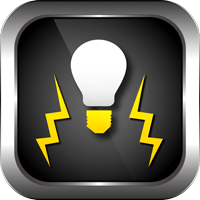
Energized Webs
Angela’s Superpower
- Compelled to help by generating endless ideas to change things for everyone’s benefit
- Does everything in her power to explore new and unusual possibilities, and analyze for uncommon connections
- Angela may sometimes fail to finish because she is is coming up with new additions
- She loves connecting ideas in unique, innovative ways, often making changes just for the fun of it
- Angela typically finds brainstorming a relief to finally let all her ideas out
Good Day

Change Motivator
Bad Day

Needy Monopolizer
Energized Webs
Angela is able to generate endless ideas and interconnecting thoughts, which is what Energized Webs is all about. Those with Energized Webs superpower are always thinking many thoughts that relate to interconnected webs of information. She is constantly flooded by many thoughts, ideas, and interpretations, often very unrelated to whatever is in front of her, and yet bringing in other information from outside the context that is quite likely to relevant and innovative.
For Angela, being asked to brainstorm is both a pleasure and a relief; she no longer has to keep trying to slow down the infinite supply of ideas. Like lightning strikes, Angela's ideas jump from topic to topic, which can sometimes be very frustrating to those around her when this power is overused.
Often when Angela should be focusing on getting a task done, Angela's brain is instead coming up with new and different ways to approach the task. In an argument, those with Energized Web superpower are often simultaneously playing devil's advocate for all sides.
She often finds her mouth open blurting out an idea or a connection without any need to decide if it is good or not.
Original work by: Sterling Bates Gene Bellotti © Step Research Corporation
03 Engagement Styles ENFP
Back to Table of ContentsThis section describes how you prefer to interact and engage when you are working with others in order to help you realize how you can make the biggest, most significant contributions.
Angela's Engagement Style:
- Your dominant engagement style describes how you prefer to interact and engage with others, especially when working on a project.
- Your engagement style can be helpful in identifying how you prefer to interact with teammates and how you make your best contributions.
- Each engagement style has several key opportunities for making a project successful.
- When an engagement style is overused, then that style can create threats to a project's success.
| Opportunities | Threats | Score | |
|---|---|---|---|
 Carefully Understand
Carefully Understand
|
Opportunities
|
Threats
|
5 |
 Refine for Perfection
Refine for Perfection
|
Opportunities
|
Threats
|
30 |
 Dynamically Explore
Dynamically Explore
|
Opportunities
|
Threats
|
55 |
 Organize and Direct
Organize and Direct
|
Opportunities
|
Threats
|
10 |
Original work by: Sterling Bates Gene Bellotti © Step Research Corporation
04 Essential Motivator - Expanded ENFP
Back to Table of ContentsEssential Motivators, your core psychological needs, values and talents as described by Linda Berens
Catalyst
Angela’s Essential Motivator
Catalyzing is natural to those who need to have a meaning and purpose to their lives.
It is the means to self-actualization.
- Angela tends to be gifted at unifying diverse peoples and helping individuals realize their potential
- She builds bridges between people through empathy and clarification of deeper issues
- She uses these same skills to help people work through difficulties
- Thus, Angela can make an excellent mediator, helping people and companies solve conflicts through mutual cooperation
- If working on a global level, Angela tends to champion a cause
- If working on an individual level, she focuses on growth and development of the person.
Goals
Unique identity
Stressors
Insincerity and betrayal
Loss of meaning
Lack of integrity
Catalyst
Angela wants to be authentic, benevolent, and empathic. She searches for identity, meaning, and significance. Angela is relationship oriented, particularly valuing meaningful relationships. Angela tends to be idealistic and visionary, wanting to make the world a better place. She looks to the future. She trusts her intuition, imagination, and impressions. Angela focuses on developing potential, fostering and facilitating growth through coaching, teaching, counseling, and communicating. She is generally enthusiastic. Angela thinks in terms of integration and similarities and looks for universals. She often is gifted in the use of metaphors to bridge different perspectives. Angela usually is diplomatic. She frequently is drawn to work that inspires and develops people and relationships.
Needs & Values
Angela's core needs are for the meaning and significance that come from having a sense of purpose and working toward some greater good. She needs to have a sense of unique identity. Angela values unity, self-actualization, and authenticity. People of this pattern prefer cooperative interactions with a focus on ethics and morality. Angela tends to trust her intuition and impressions first and then seek to find the logic and the data to support her. Given Angela's need for empathic relationships, she learns more easily when she can relate to the instructor and the group.
Skill Set
- Diplomatic Skill Set
- Build bridges between people
- Has empathy
- Strive to unify by understanding and resolving deeper issues while honoring individual uniqueness
- Move to a level of abstraction to see how two seemingly different views are alike and then to choose a symbolic way of communicating the similarity to transcend differences
- Help others harmonize and clarify their values to bring unity to the individual and the group
- Have foresight and vision with implications for developing the people involved, then communicating that vision so it is accepted and followed
- Help others find their path and inspire them to follow it
- Envision and then mentor others to achieve the envisioned potential
05 Interaction Style - Expanded ENFP
Back to Table of ContentsHow you tend to express yourself to others.
Energizer - Get-Things-Going
Angela’s Interaction Style
- Energetic
- Animated
- Gregarious
- Expressive
- Enthusiastic
- Engaging
- Persuasive
- Casual
Goals
To involve and be involved
To move things along
Stressors
Not being a part of what's going on
Feeling unliked or not accepted
- Get everyone involved participating
- Move the group to action along their paths
- Facilitate the group's process to work with people where they are to get them to where they are going
- Get the energy moving toward an emerging vision
- Make enthusiastic, collaborative decisions that ensure buy-in
- Focus on interactions to get more from the group than group members can get individually
- Explore options that keep things moving along
- Make preparations to make things easy for others
- Discover new ways of seeing things and doing things
- Share insights about what something means and what is really going on
Energizer - Get-Things-Going
Angela's theme is persuading and involving others. She thrives in facilitator or catalyst roles and aims to inspire others to move to action, facilitating the process. Angela's focus is on interaction, often with an expressive style. She gets things going with upbeat energy, enthusiasm, or excitement, which can be contagious. Exploring options and possibilities, making preparations, discovering new ideas, and sharing insights are all ways she gets people moving along. Angela wants decisions to be participative and enthusiastic, with everyone involved and engaged.
06 Interaction Styles Comparison ENFP
Back to Table of ContentsShowing how you tend to use all four interaction styles.
Angela's Interaction Style:
Energizer - Get-Things-Going
Chart-the-Course
To see movement and progress
Don't see progress
Get-Things-Going
To move things along
Feeling unliked or not accepted
Behind-the-Scenes
To integrate and harmonize
Pressed to decide too quickly
In-Charge
To see action taken
Nothing being accomplished
07 Visual Type™ and Go-To Behaviors ENFP
Back to Table of ContentsThis section is a visual model of Carl Jung’s Psychological Types showing how you use all eight behaviors and which two are dominant for you.
Visual Type™ provides a visual guide to the predictive use and accessibility of each behavior and an instantly recognizable way to see differences between people. This helps individuals with self-awareness. It also helps others understand what they can expect from the individual. The goal of this section is to make it immediately obvious to non experts how the functions relate to each other and the person based on their whole type.
Invent
Look to the new and different ideas and explore many possibilitiesAngela uses brainstorming, a verbal questioning to identify patterns that provide insight. Angela looks to Invent as her go-to behavior for gathering information, she prefers seeking answers through brainstorming, identifying patterns and innovation. Angela looks outside the box for answers, seeking something new.
Value
Decide based on ethically right or wrong and sync with individual valuesAngela aligns personal missions with being understanding. She decides in a way that promotes win-win solutions with the priority on other people's feelings and her own personal ethics and morals. Angela makes decisions that focus on what is right or wrong according to her internal values. Angela then expresses her internal values through external actions.
Understanding Angela's Visual Type™
- Angela's largest go-to box is Invent: showing her strength of being able brainstorm new ideas, start new projects, think out of the box and find creative solutions to problems.
- Angela's supporting box is Value, below the line, which may be unseen by others unless she verbalizes how her ideas are supporting or undermining her deeply-held values.
- Angela's other three top boxes - Now, Execute and Consideration - are drafted to support her Invent function, which she experiences as her Energize Webs Superpower.
You use all eight Go-To boxes but we expect that you find certain ones easy and fun and others slow and tough.
Think of the box size as telling you how natural you are likely to find activities related to that mental function. The smaller the box, the more energy it will likely take you to do any related activities. The bigger the box, the more likely you are to get energy from doing related activities.
The largest box is your largest function or Superpower.
The boxes above the line are what other people see - they are extraverted. The boxes below the line are introverted and are below the surface.
If your main go-to box is introverted, your most commonly used mental function is invisible to others. If your main go-to box is extraverted, others cannot see your supporting introverted box.
- Exciting
- Quick acting
- Risk taking
- Details
- Immediate need
- Exciting
- Quick acting
- Risk taking
- Details
- Immediate need
- Remembering
- Tells it from beginning to end
- Recalls in time sequence
- Details
- Nothing is too old
- Remembering
- Tells it from beginning to end
- Recalls in time sequence
- Details
- Nothing is too old
- Sharing ideas
- Takes a global perspective
- Brainstorming
- Identifies patterns
- Is not bothered by details
- Sharing ideas
- Takes a global perspective
- Brainstorming
- Identifies patterns
- Is not bothered by details
- Gaining insight from the unknown
- Having the “AHA”
- Connects the unconnected
- Difficult to explain
- Processes randomly
- Gaining insight from the unknown
- Having the “AHA”
- Connects the unconnected
- Difficult to explain
- Processes randomly
- akes a removed or objective perspective
- Sounds level headed
- Works from a defendable position
- Uses external tools
- Arranges data logically
- akes a removed or objective perspective
- Sounds level headed
- Works from a defendable position
- Uses external tools
- Arranges data logically
- Invisible to others
- Everything is connected
- Developed with precision
- Nothing exists unless it is complete
- Systematic process
- Invisible to others
- Everything is connected
- Developed with precision
- Nothing exists unless it is complete
- Systematic process
- Everyone is at peace
- Wants everyone to be happy
- Appreciates others’ involvement
- Harmony in the moment
- Connecting with others
- Everyone is at peace
- Wants everyone to be happy
- Appreciates others’ involvement
- Harmony in the moment
- Connecting with others
- Shielded from others
- Timeless
- Peace within
- Going it alone
- Often visible only when violated
- Shielded from others
- Timeless
- Peace within
- Going it alone
- Often visible only when violated
Now
: Look to the present and immediate needs and explore what is currently availableNow is very adept at identifying details about something that is happening right now and can be acquired through the five senses. People using NOW tend to be very aware and in the moment, seeking tactics that they can implement right now. Now looks to the present and the immediate moment for solutions.
Engaging to Experience
Alive in the moment and aware of what the senses are able to immediately experience
What's Happening Now
Alive in the moment and aware of what the senses are able to immediately experience
The Now function triggers an immediate reaction to or an engagement of what is perceived, so it may appear as if one is quickly changing from one activity to another or shifting interest quickly from one thing to another.
People who prefer to or naturally use Now to acquire information report liking to "live life to the fullest" or "live on the edge". Often the physical risks are exciting. They also report doing things or saying things that get a recognition or a reaction from others in the moment.
Stabilize
: Look to the past, traditions and what worked and focus on consistencyStabilize is abot keeping an internal database of details that have been learned in the past. Stabilize compares today's data with past data to make an informed decision. People using Stabilize tend to check their memory, make comparisons to the past, and in general look to the past to verify information.
Reliving to Verify
Recalling the details of past experiences and reliving the motions that accompany them
Resurrecting the Past
Recalling the details of past experiences and reliving the motions that accompany them
When active, Stabilize might appear to be slow in responding or unmoved by the present moment. This is because the focus is not on the present event. Instead it is on examining all past similar experiences.
When people who prefer, or naturally use, this mental function share the experience it is as if they were sharing the video tape that is playing in the brain. They also know that the devil is in the details, so expect them to be uncomfortable leaving out the details when they are talking and wanting you to include the details when you are talking.
Recognize that the experiences being recalled may have occurred eons ago, yet they are being talked about as if they only occurred yesterday.
Invent
: Look to the new and different ideas and explore many possibilitiesInvent is about brainstorming, a verbal questioning to identify patterns that provide insight. People using Invent tend to prefer seeking answers through brainstorming, identifying patterns and innovation. Invent looks outside the box for answers, seeking something new.
Recognizing Patterns and Possibilities
Creating possibilities for the future and spontaneously recognizing patterns and connections
Envisioning to Improve
Creating possibilities for the future and spontaneously recognizing patterns and connections
Invent when active in a positive way tends to view the opportunities and possibilities positively. Information shared through this function may seem to be superficial or broad brush as the details or what is beneath the surface can be filled in later. The expressions tend to be global in nature.
Insight
: Look to how things connect, the future and predict possible outcomesInsight is about the process of identifying seemingly disconnected patterns to result in instant insight into a problem or situation. When using Insight people tend to visualize their goal or end result, focus on strategy, synthesize data almost unconsciously and predict results with surprising accuracy. Insight looks to and visualizes the future for answers.
Discerning the Essence
Synthesizing information and identifying the central theme, vision, or significance
Insight of Holistic Meaning
Synthesizing information and identifying the central theme, vision, or significance
The insights that are received are like nuggets of gold; however, often the person receiving the nugget does not know how to immediately explain it to others so that they perceive it as a nugget of gold as well. This is often because the nugget appeared as a flash of light or insight without supporting information, so when one attempts to explain why the insight should be trusted the mind is blank. Reflection time is almost always needed to allow some bits of information to drift into consciousness to support the value of the insight. Memory is symbolic and images and ideas are ever-changing.
Execute
: Decide based on measurable goals and drive towards objectivesExecute is about plans, organizing, schedules, and measures. Execute structures the decision-making process by directing and interacting with other people. Execute focuses on measurable goals. When using it, people tend to think out loud, notice quickly when something is out of sequence or order, set objectives and criteria for success, and create step-by-step procedures. Execute looks to influence and organize the world, even when not solicited to do so.
Planning and Regulating
Establishing goals and applying objective analysis to arrive at a logical, defendable decision
“Operationalizing”
Establishing goals and applying objective analysis to arrive at a logical, defendable decision
With Execute everything is supported with logically analyzed data. Execute analyzes information within specific boundaries. Western states are different from northeastern states. We can think of Execute as establishing boundaries for the problem or boundaries regarding information that will be considered. Execute involves living by specific rules, regulations and laws and believing others should, as well.
Analyze
: Decide based on logically correct or incorrect and evaluate the best approachAnalzye is about using an internal, logic-based decision-making process that focuses on what is correct or incorrect. When using Analyze people tend to look inside before making decisions, using their mind to create order, to organize and categorize information, identify anomalies, deduce probabilities and understand how things work.
Understanding Systems
Repeatedly applying system analysis to data to fit them in one’s subjective mental framework
“That’s Better Defined This Way.”
Repeatedly applying system analysis to data to fit them in one’s subjective mental framework
These frameworks are built with precision and take a long time to be completed; therefore, they are not going to be quickly discarded in favor of a different framework. Because this is an introverted function the framework or system is not visible to others. Others often do not get a glimpse of the framework until they arrive at a decision that is not consistent with the framework, at which time they get to witness the volcanic explosion.
One can think of Analyze as an internal filing system. Each file contains sub-files, which contain sub-files, and so-on. Thus, when one is using Analyze, the time it takes to evaluate information may take a substantial amount of time, as the person must check to see if the information fits within one's complex filing system. If there is no place in the filing system for the piece of information to go, it will be rejected until more information is received.
Consideration
: Decide based on people's needs and empathize with othersConsideration is about giving the other person's personal needs high importance in making a decision. Consideration gives priority to the feelings of others. When using Consideration people tend to be friendly and considerate, try to create harmony between other people, act with kindness, and will disconnect with people who do not show that they care. Consideration looks to help others grow.
Affirming and Validating
Expressing appropriate concern and appreciation so group harmony is maintained
“You Really Did a Great Job”
Expressing appropriate concern and appreciation so group harmony is maintained
Consideration is genuinely 'other focused.' It is the mental function used to assess how others will react to certain decisions. It involves knowing the appropriate thing to do and is satisfied when others are content and working together.
This function evaluates based on the possible impact on others. It strives for peace externally or peace among others and is about making sure others are not disturbed, annoyed or in conflict. Consideration involves conversing and connecting with others, being with others, appreciating others and celebrating with others. It's all about 'others.'
Value
: Decide based on ethically right or wrong and sync with individual valuesValue is about aligning personal missions with being understanding. Value decides in a way that promotes win-win solutions with the priority on other people's feelings and their own personal ethics and morals. When using Value people tend to make decisions that focus on what is right or wrong according to their own internal values. They then expresses their internal values through external actions.
Liking or Disliking
Feeling internal tranquility when reality matches what is uniquely and deeply valued
“This is the Only Acceptable Way”
Feeling internal tranquility when reality matches what is uniquely and deeply valued
These values are shielded and protected from attack by others and thus may make us feel alone, vulnerable, or even on the defensive. There is a bit of mystery as to who this person is and there is a sense of tranquility and personal serenity. The values involved change very little, if at all, over time.
When these values are attacked, the reaction is often as shocking to those triggering the reaction as it is to the one who is reacting. It is as if a sudden, unexpected explosion has occurred that is the opposite of the serene inner harmony that is generally sought. Value strives for peace internally or an internal calmness and sense that everything is right.
Original work by: Sterling Bates Gene Bellotti Robert McAlpine © Step Research Corporation
08 Type Dimension Preferences ENFP
Back to Table of ContentsThese describe how your preferences fit in with 4 core dimensions of your personality
Preference for Extraversion
The opposite is called IntroversionMore Likely You:
- Energised by the outer world
- Talk, think, talk
- Action
- Breadth
Less Likely You:
- Energised by the inner world
- Think, talk, think
- Reflection
- Depth
Preference for Intuition
The opposite is called SensingMore Likely You:
- Future
- The big picture
- Visionary
- The sixth sense
Less Likely You:
- Here and now
- Details
- Realistic
- The five senses
Preference for Feeling
The opposite is called ThinkingMore Likely You:
- Values
- People centred
- Harmony
- Compassion
Less Likely You:
- Logic
- Task centred
- Competence
- Fairness
Preference for Perceiving
The opposite is called JudgingMore Likely You:
- Freedom
- Process
- Flexibility
- Just in time
Less Likely You:
- Control
- Closure
- Plans
- In good time
Original work by: Mette Babitzkow Boje Tina Brøndum Kristjánsson © Step Research Corporation
09 Whole Type ENFP
Back to Table of ContentsThe type code embodies a simple presentation, it was meant to represent a whole personality pattern. We are more than the letters of the code or the sum of our preferences.
Discoverer Advocate™
Angela’s Whole Type
- Inspiring and facilitating others.
- Exploring perceptions.
- Talent for seeing what’s not being said and voicing unspoken meanings.
- Seek to have ideal relationships.
- Recognize happiness.
- Living out stories.
- Want to authentically live with themselves.
- Respond to insights in the creative process.
- Finding the magical situation. Restless hunger for discovering their direction.
Discoverer Advocate™ Snap Shot
- Angela's theme is inspiration, both of themselves and others.
- Her talents lie in grasping profound significance, revealing truths, and motivating others.
- Very perceptive of others’ hidden motives and purposes, Angela is interested in everything about individuals and their stories as long as they are genuine.
- She has a contagious enthusiasm for “causes” that further good and develop latent potential and have the same zeal for revealing dishonesty and inauthenticity.
- Frequently, Angela is moved to enthusiastically communicate their “message.”
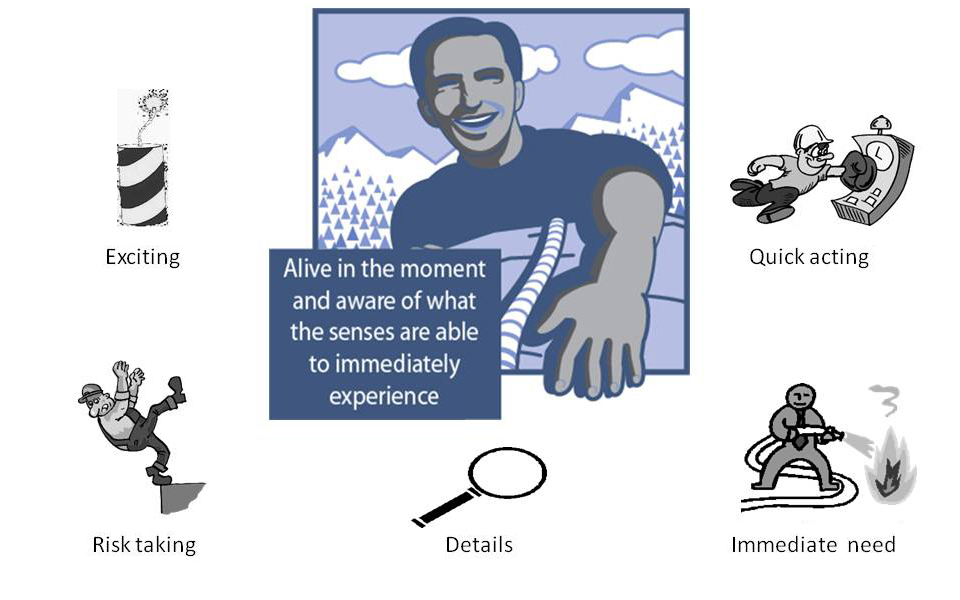
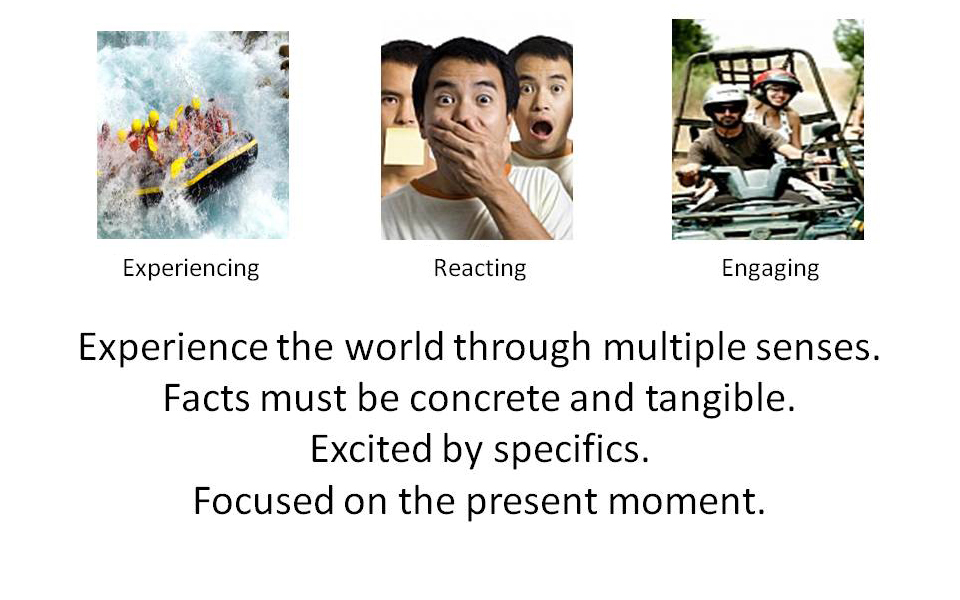 Now is about immediately engaging the world around us. We do this by perceiving information through any of our five senses. We might even be using multiple senses simultaneously. Remember we are talking about concrete information; otherwise, it would not be information we perceived through one of the senses.
Now is about immediately engaging the world around us. We do this by perceiving information through any of our five senses. We might even be using multiple senses simultaneously. Remember we are talking about concrete information; otherwise, it would not be information we perceived through one of the senses.
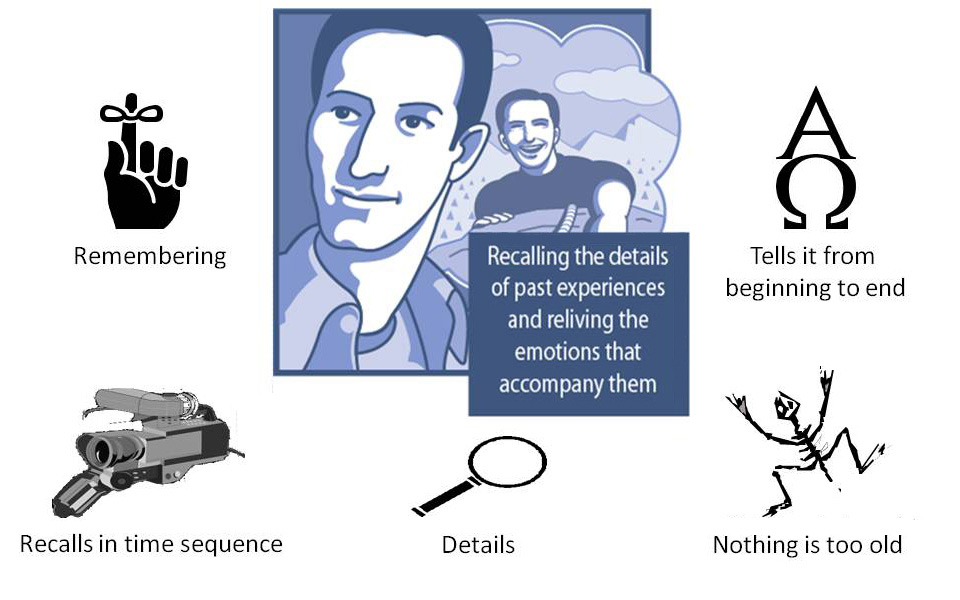
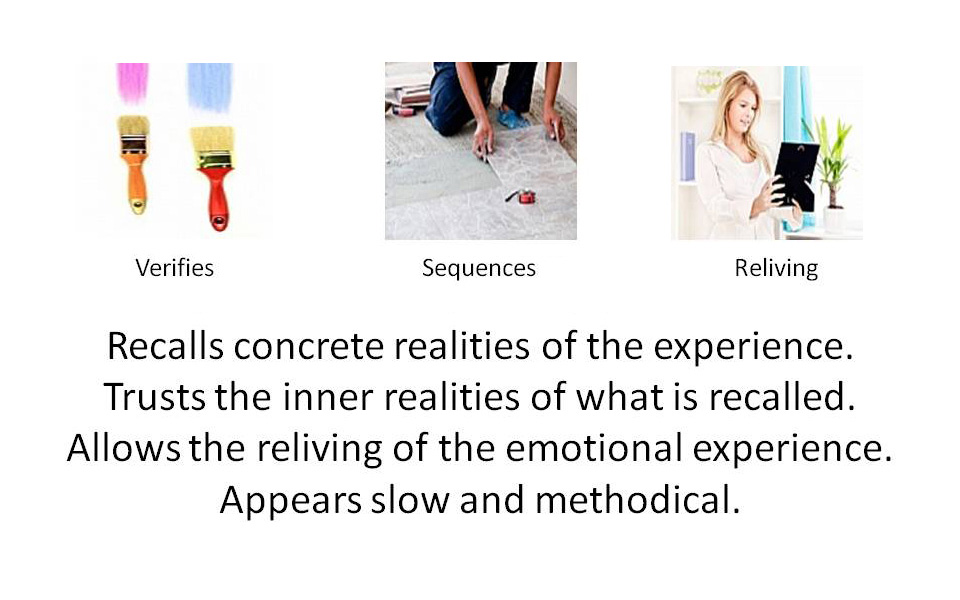 Stabilize is about checking out the present information by comparing it to previous experiences with similar information. We do this by recalling and reliving the past experiences in our lives. These are concrete experiences that include the emotional experiences or reactions we had to the experience being recalled. The recalled experiences are recalled from start to finish and if they are shared everything from start to finish must be shared.
Stabilize is about checking out the present information by comparing it to previous experiences with similar information. We do this by recalling and reliving the past experiences in our lives. These are concrete experiences that include the emotional experiences or reactions we had to the experience being recalled. The recalled experiences are recalled from start to finish and if they are shared everything from start to finish must be shared.
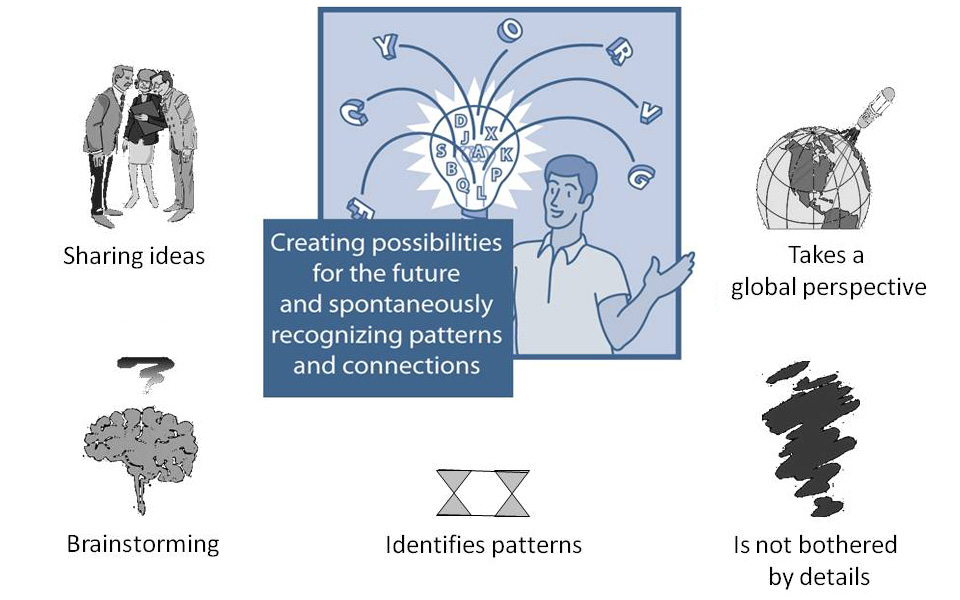
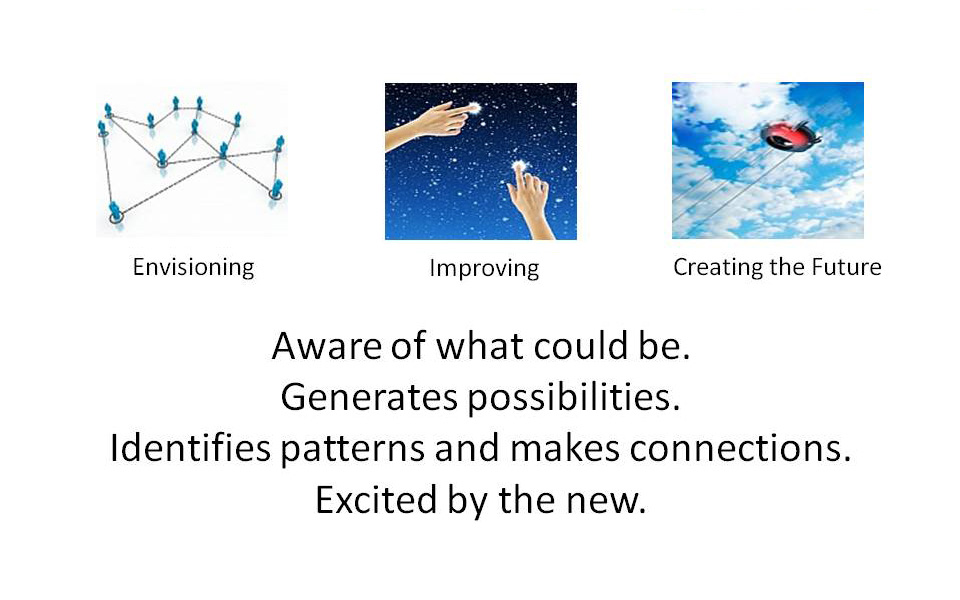 Invent is about identifying possibilities and opportunities related to what is happening in the real world. It is generating new ideas based on old ones. It is creating new ideas based on what someone else has shared. It expands one idea into many possibilities without the need for precision or detail.
Invent is about identifying possibilities and opportunities related to what is happening in the real world. It is generating new ideas based on old ones. It is creating new ideas based on what someone else has shared. It expands one idea into many possibilities without the need for precision or detail.
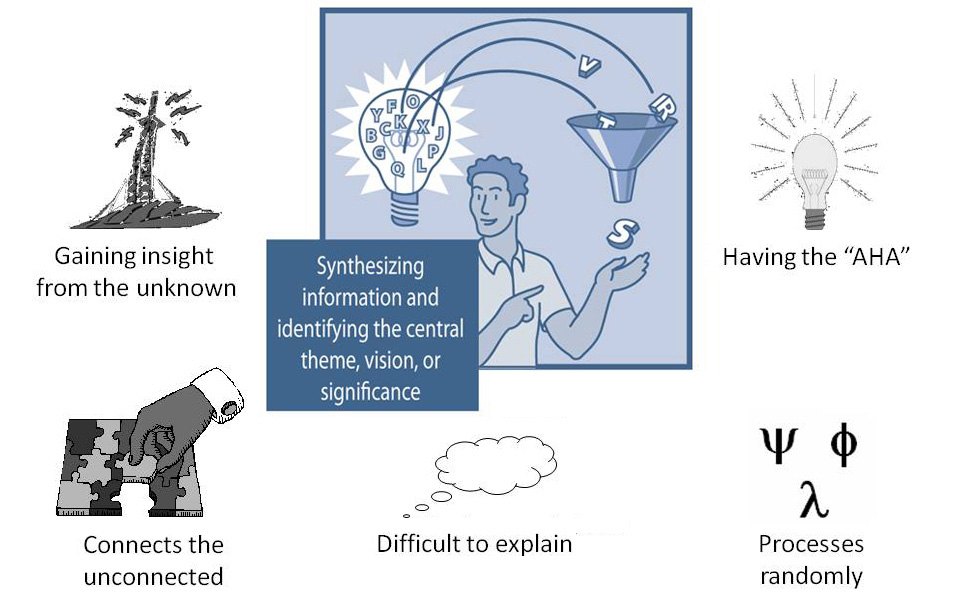
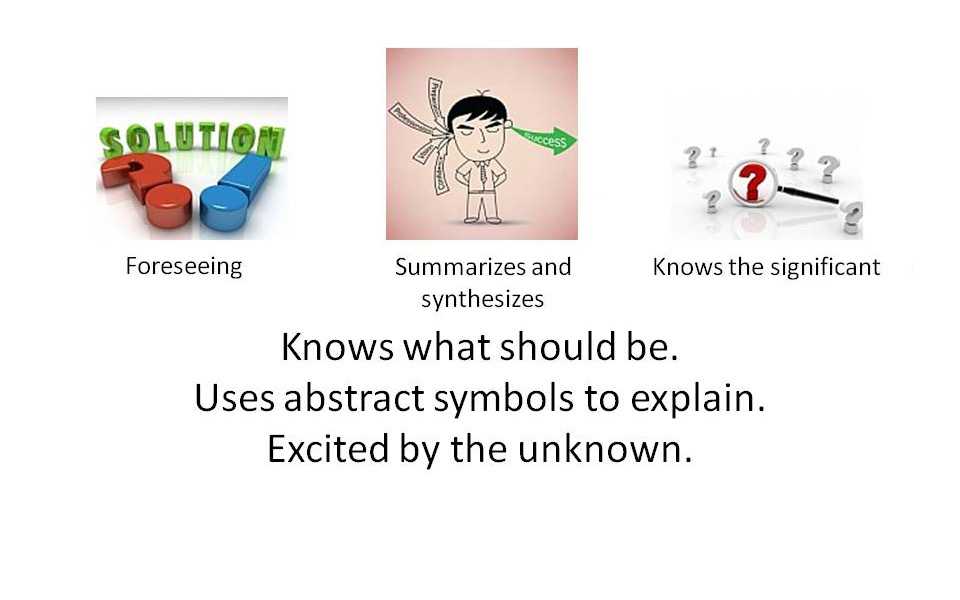 Insight identifies the opportunity or possibility that is the "best" without really knowing how it was identified. It is like a receiver getting signals from an unknown TRUSTED source. It tends not to focus on intermediate steps instead focusing on the end goal. One might connect with Covey's "Start with the end in mind" as an introverted intuiting approach.
Insight identifies the opportunity or possibility that is the "best" without really knowing how it was identified. It is like a receiver getting signals from an unknown TRUSTED source. It tends not to focus on intermediate steps instead focusing on the end goal. One might connect with Covey's "Start with the end in mind" as an introverted intuiting approach.
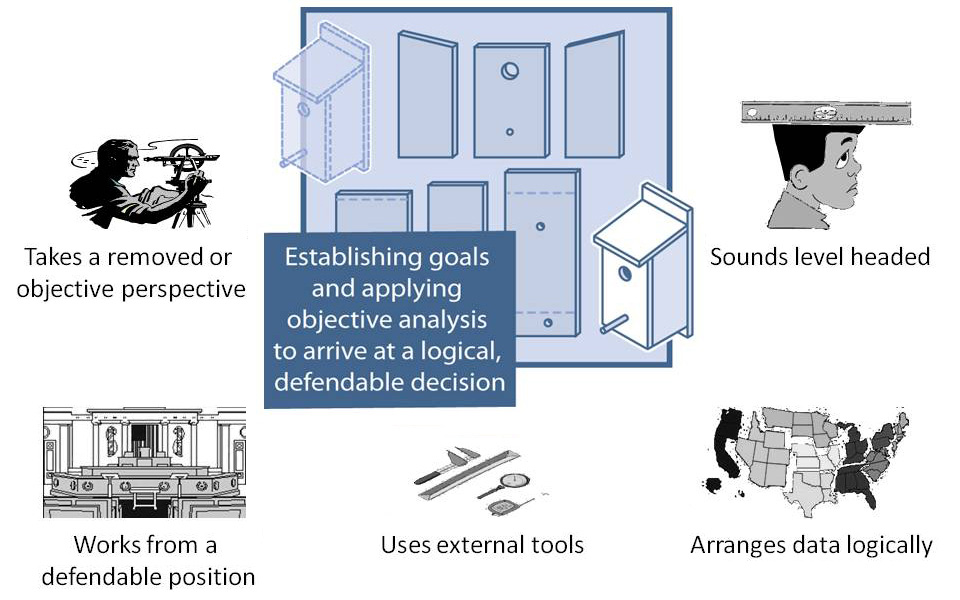
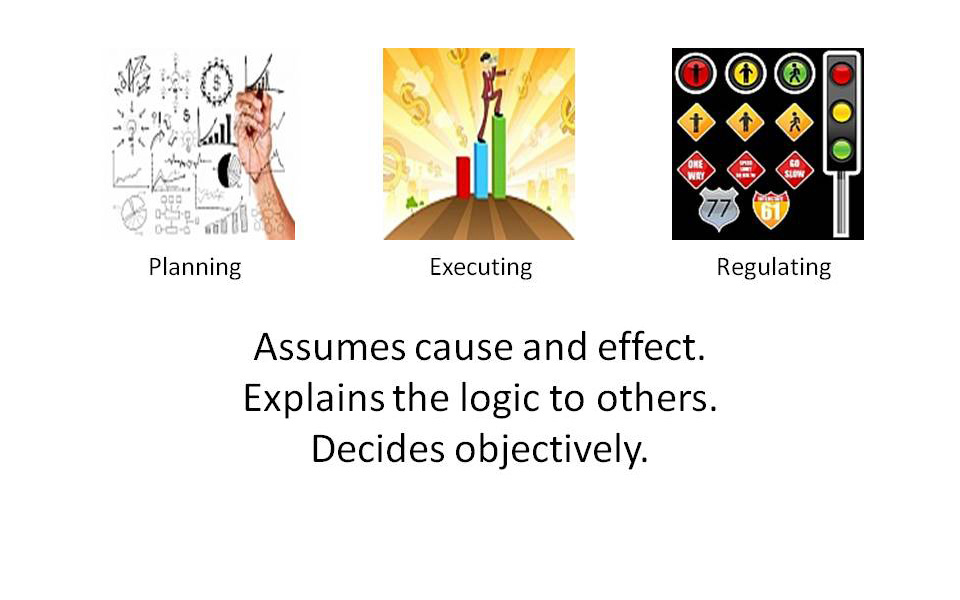 Execute uses accepted tools and techniques to evaluate the information much like surveying instruments are used to determine a specific location. This process organizes information in an orderly manner so the information can be analyzed objectively or impersonally.
Execute uses accepted tools and techniques to evaluate the information much like surveying instruments are used to determine a specific location. This process organizes information in an orderly manner so the information can be analyzed objectively or impersonally.
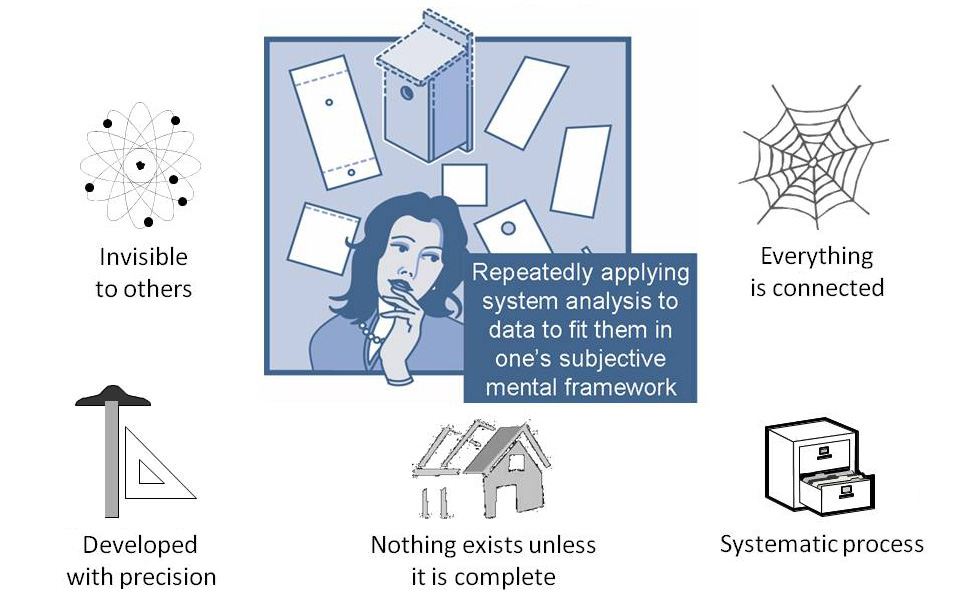
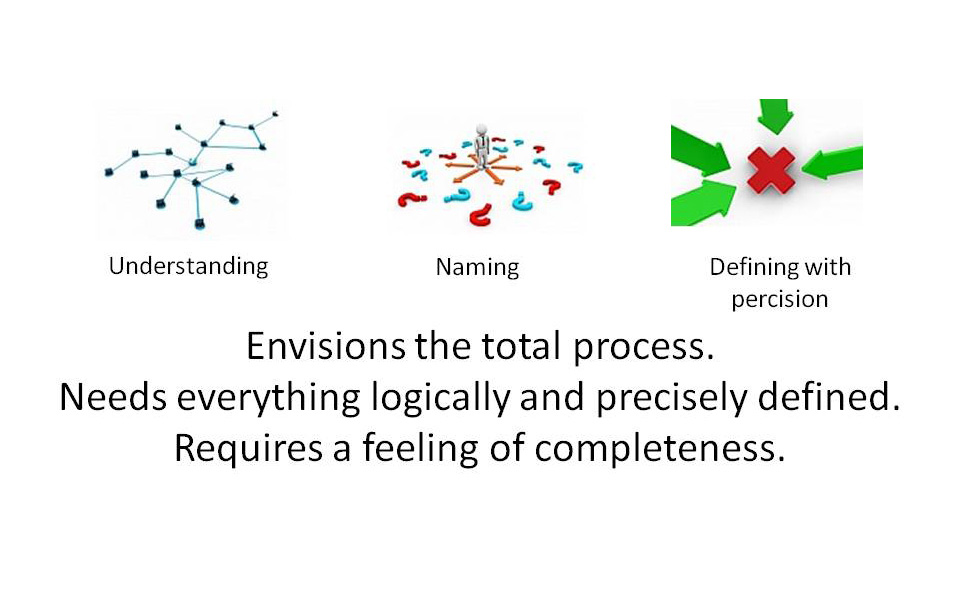 Analyze evaluates information based on how consistently and precisely the information fits within established internal systems or frameworks.
Analyze evaluates information based on how consistently and precisely the information fits within established internal systems or frameworks.
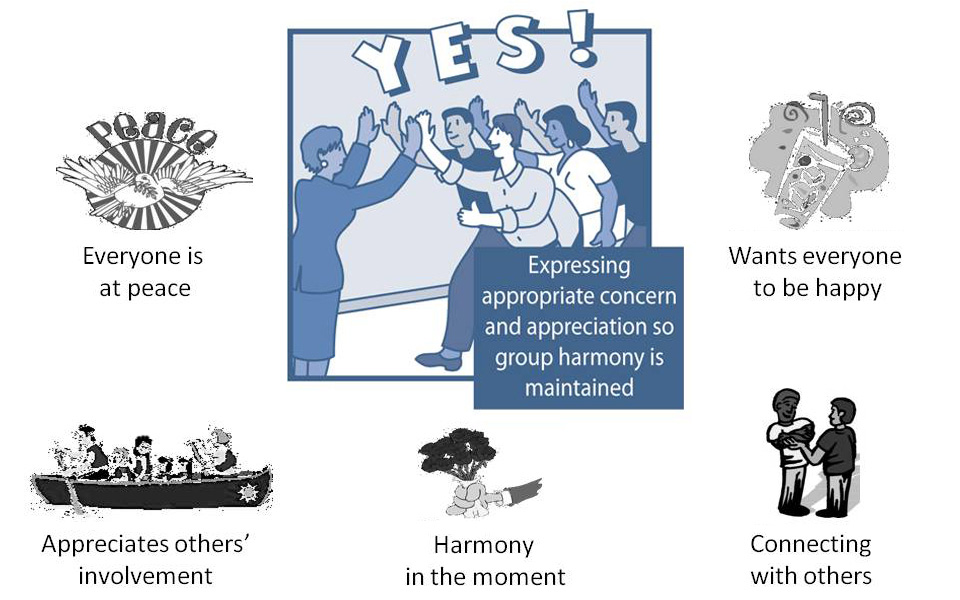
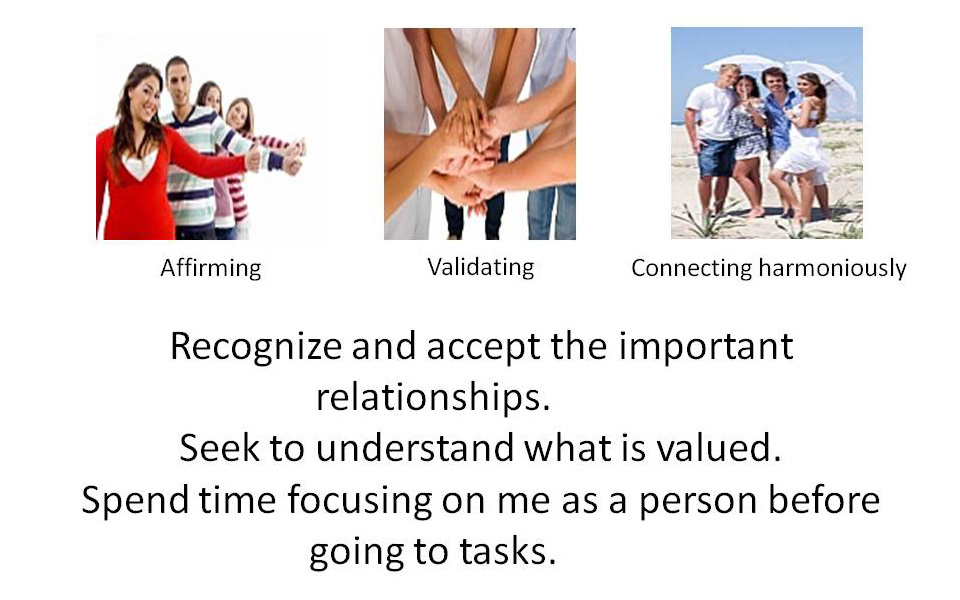 Consideration is about tuning in/noticing/reading the mood or the practical needs of others and then addressing or satisfying those needs.
Consideration is about tuning in/noticing/reading the mood or the practical needs of others and then addressing or satisfying those needs.
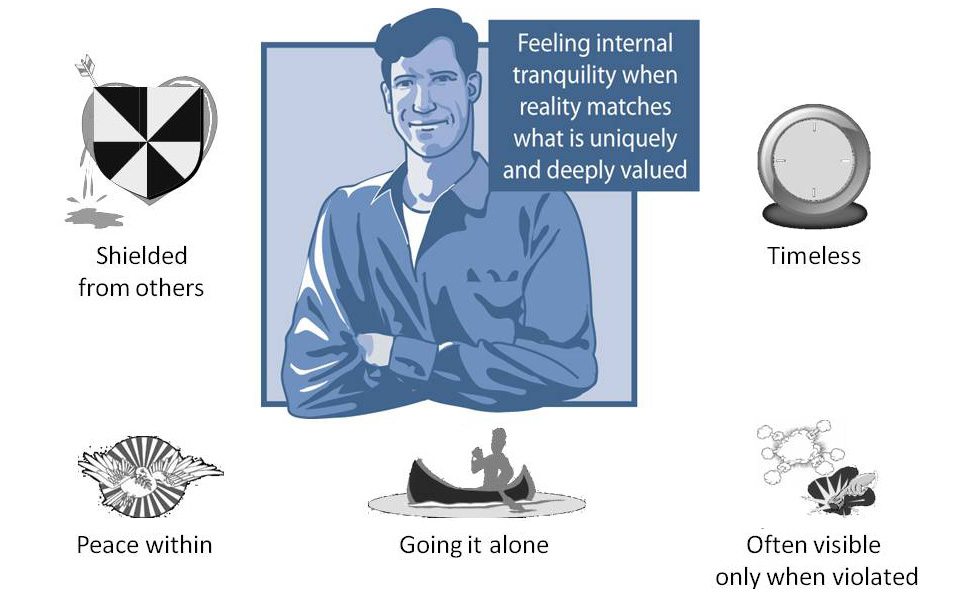
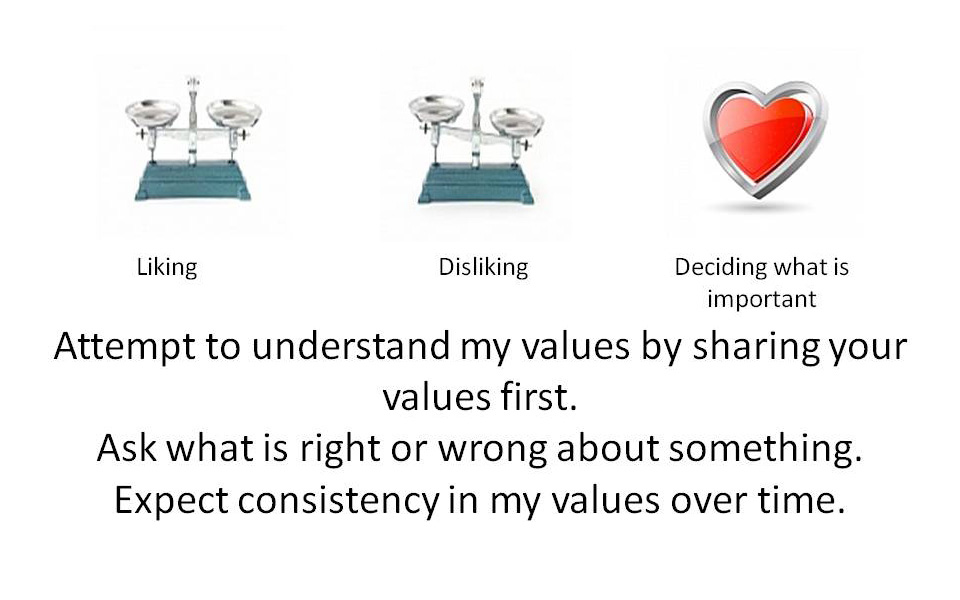 Value evaluates information based on one's unique values. It is easy for one to apply these values to identify what is right, but it is difficult for one to explain to others what one is using to determine what is right.
Value evaluates information based on one's unique values. It is easy for one to apply these values to identify what is right, but it is difficult for one to explain to others what one is using to determine what is right.